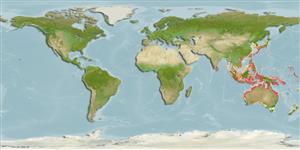Environment: milieu / climate zone / depth range / distribution range
Ecology
Marine; reef-associated; depth range 2 - 25 m (Ref. 90102). Tropical
Indo-West Pacific: Indo-Malayan region to Australia, north to Japan.
Size / Weight / Age
Maturity: Lm ? range ? - ? cm
Max length : 31.0 cm TL male/unsexed; (Ref. 3132)
Often found in weedy areas of coastal reefs (Ref. 9710) and trawling grounds. The flesh is good for human consumption.
Life cycle and mating behavior
Maturity | Reproduction | Spawning | Eggs | Fecundity | Larvae
Allen, G.R. and R. Swainston, 1988. The marine fishes of north-western Australia: a field guide for anglers and divers. Western Australian Museum, Perth. 201 p. (Ref. 3132)
IUCN Red List Status (Ref. 130435)
Threat to humans
Harmless
Human uses
More information
Common namesSynonymsMetabolismPredatorsEcotoxicologyReproductionMaturitySpawningSpawning aggregationFecundityEggsEgg development
ReferencesAquacultureAquaculture profileStrainsGeneticsElectrophoresesHeritabilityDiseasesProcessingNutrientsMass conversion
Tools
Special reports
Download XML
Internet sources
Estimates based on models
Preferred temperature (Ref.
123201): 24.1 - 29.3, mean 28.6 °C (based on 2470 cells).
Phylogenetic diversity index (Ref.
82804): PD
50 = 1.0000 [Uniqueness, from 0.5 = low to 2.0 = high].
Bayesian length-weight: a=0.01995 (0.00943 - 0.04220), b=2.93 (2.75 - 3.11), in cm total length, based on LWR estimates for this (Sub)family-body shape (Ref.
93245).
Trophic level (Ref.
69278): 2.8 ±0.4 se; based on size and trophs of closest relatives
Resilience (Ref.
120179): Medium, minimum population doubling time 1.4 - 4.4 years (Preliminary K or Fecundity.).
Fishing Vulnerability (Ref.
59153): Low vulnerability (21 of 100).
Nutrients (Ref.
124155): Calcium = 44.2 [18.2, 106.4] mg/100g; Iron = 0.634 [0.300, 1.466] mg/100g; Protein = 18.1 [15.8, 20.3] %; Omega3 = 0.0923 [, ] g/100g; Selenium = 30.9 [14.8, 68.9] μg/100g; VitaminA = 55.3 [15.0, 195.8] μg/100g; Zinc = 1.25 [0.83, 1.98] mg/100g (wet weight);
